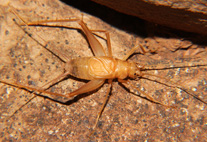Abstract
We describe a new species of the genus Endecous Saussure (1878), recorded at the Lapa do Cipó and Olhos d’Água caves, which are located in the Itacarambi municipality, Minas Gerais state, Eastern Brazil. Another species, E. aguassay Mews, 2008 was recordedin the surroundings of the caves. The genus Endecous corresponds to the most common cricket in Brazilian hypogean environments. In general, these crickets inhabit the areas around cave entrances up to the aphotic zones of caves. The genus Endecous is the only cave cricket to present troglobiomorphosis, i.e., an apterous condition. The distribution of the new species is limited to these two caves, which suggests an endemism in this karst system similar to the distribution of other endemic animals, such as harvestmen and amblypygid arachnids. This species is the sixth troglobitic one described for Olhos d’Água cave, which sets this cave as a spot of subterranean fauna in Brazil.

